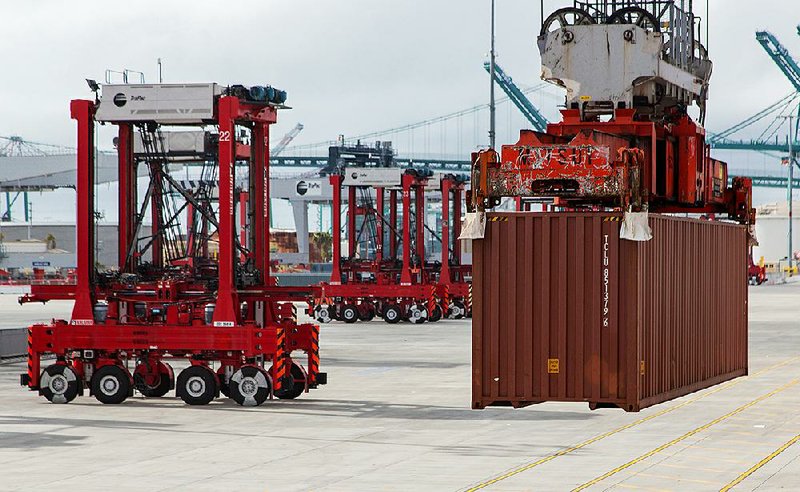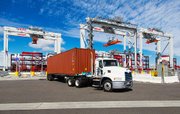On one end of a dock at America's busiest port, tractor-trailers haul containers through dense, stop-and-go traffic. Sometimes they collide. Sometimes the drivers must wait, diesel engines idling, as piles are unstacked to find the specific container they need.
A few hundred yards away, advanced algorithms select the most efficient pathway for autonomous carriers to move containers across the wharf. The four-story-high orange machines cradle their cargo, passing quietly within inches of one another, at speeds of up to 18 mph, but never touching. Self-driving cranes on tracks stack the containers and then deliver them to waiting trucks and trains with minimal human intervention.
TraPac LLC's Los Angeles marine-cargo facility demonstrates how autonomous technology could revolutionize freight transport as much as or more than personal travel. TraPac's equipment doubles the speed of loading and unloading ships, saving money and boosting profits. Their impact is rivaling that of containerization, which eliminated most manual sorting and warehousing on docks after World War II.
"Self-driving won't just rebuild the current freight system, it will create a whole new way of thinking about it," said Larry Burns, a former research and development chief at General Motors and now a consultant at Alphabet's Google unit.
"It will happen sooner with goods movements than with personal transportation, because the economics are crystal clear," Burns said.
Commercial shipments currently produce half the state's toxic diesel-soot emissions.
More automation also could help Gov. Jerry Brown achieve his goal of zero-emission freight movement in California. Commercial shipments currently produce half the state's toxic diesel-soot emissions and 45 percent of the nitrogen oxide that plague Los Angeles with the nation's worst smog.
In Long Beach, where most residents are Hispanic, black or Asian, an estimated 15 percent of the children have asthma, 6 percentage points higher than the national average, according to a community coalition report.
The state's Air Resources Board is in charge of drafting a Sustainable Freight Action Plan, including new regulations on vehicles and fuels, as well as subsidies for new infrastructure, communications and operating procedures, according to board Chairman Mary Nichols.
Brown wants 100,000 zero-emission freight-hauling machines in California by 2030, according to recent workshop presentations to the board. These could include self-driving cranes and carriers like those at TraPac.
"This may be the most difficult and complex challenge we've ever undertaken," said Dan Sperling, a member of the board and professor of civil engineering and environmental science at the University of California, Davis. "We're trying to change the entire freight system."
The ports of Long Beach, Los Angeles and Oakland handle 40 percent of U.S. container traffic, and upgrading them to all-electric equipment that's often self-driving will cost $35 billion in the next 30 years, compared with $7 billion to replace existing technologies, according to a December study for the Pacific Merchant Shipping Association.
Many terminal operators -- plagued by plunging freight rates -- won't be able to afford the transition without government help, said Mike Jacob, a vice president for the association.
"I'm cautiously optimistic that so far, the administration has shown a willingness to address the question of how to creatively fund and finance these future technologies," he added.
Nichols said she knows where to look for money. For the first time ever, she says, Brown is insisting that the state government bring all its purchasing power to bear on the single goal of sustainable freight. The California Department of Transportation won't approve state and federally funded highway projects, for example, without checking with the board on the air-quality impact.
The state has already contributed grants for battery-powered tractor-trailers at a new automated facility in the Long Beach Container Terminal, which began receiving cargo last month. The port is sharing the $2 billion redevelopment cost with the shipper, Orient Overseas Container Line, a subsidiary of Hong Kong-based Orient Overseas International Ltd. It will recover its investment as the shipper makes payments on its 40-year terminal lease, said Art Wong, spokesman for the Port of Long Beach.
The new facility will use electric, self-driving cranes and carriers that follow the paths of transponders buried in the cement on the dock. The new equipment will double the volume of containers the terminal handles while cutting emissions in half, Wong said.
The Port of Los Angeles and TraPac, a unit of Mitsui O.S.K. Lines Ltd., are investing $693 million in four dozen self-driving cranes and automated carriers, plus related infrastructure. Of this amount, $63 million comes from the state of California.
As the carriers scamper back and forth across the dock, each device changes direction independently from the rest -- without apparent need for human help. A few dozen people watch and monitor in faraway control rooms.
On the wharf itself, TraPac only uses people to run the cranes that unload ships and to drop containers the last few feet onto waiting trucks and trains.
As they grapple with this onslaught, the California facilities lag far behind some counterparts in adopting autonomous technology. Since 1993, Rotterdam has used precursors to the self-driving equipment TraPac is installing. Europe's largest facility, it now has five fully automated deep-sea terminals.
Information for this article was contributed by James Nash of Bloomberg News.
SundayMonday Business on 05/02/2016

